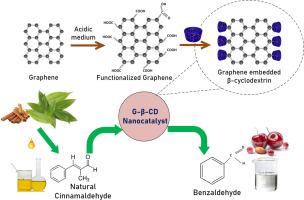Investigation of acidic functionalized graphene-supported β-cyclodextrin as a heterogeneous nanocatalyst for the green synthesis of benzaldehyde from natural cinnamaldehyde
IF 6.3
3区 工程技术
Q1 ENGINEERING, CHEMICAL
Journal of the Taiwan Institute of Chemical Engineers
Pub Date : 2025-07-21
DOI:10.1016/j.jtice.2025.106298
引用次数: 0
Abstract
Background
Benzaldehyde, the simplest aromatic aldehyde and the second most widely used flavor compound, has a low yield from natural sources. One approach to synthesize green benzaldehyde is the alkaline oxidation of cinnamaldehyde or natural cinnamon oil. However, the use of strong oxidizing agents or extreme reaction conditions can affect the natural aroma of benzaldehyde. Therefore, a method involving milder conditions is crucial to address this problem.
Method
In this work, graphene nanoplatelets were acid-functionalized to enhance their binding affinity towards β-cyclodextrin catalyst, enabling the synthesis of a novel acidic functionalized graphene-supported β-cyclodextrin nanocatalyst for the green conversion of natural cinnamaldehyde to benzaldehyde. The effects of various operating parameters on the conversion, selectivity, and reusability of the synthesized nanocatalyst were studied. Additionally, the reaction kinetics and the role of the nanocatalyst in lowering the activation energy of the reaction were investigated.
Significant findings
A maximum cinnamaldehyde conversion of 91% with 69% yield and 86% benzaldehyde selectivity was achieved at optimal experimental conditions. The graphene-supported β-cyclodextrin nanocatalyst reduced the activation energy by 32.32% compared to graphene alone and by 23.54% compared to β-cyclodextrin alone. The incorporation of β-cyclodextrin onto the graphene support improved substrate specificity, and the synergistic effects between functionalized graphene and β-cyclodextrin make the nanocatalyst highly promising for the commercial green synthesis of benzaldehyde from cinnamaldehyde.

酸性功能化石墨烯负载β-环糊精作为非均相纳米催化剂在天然肉桂醛绿色合成苯甲醛中的研究
苯甲醛是最简单的芳香醛,也是应用第二广泛的香料化合物,其天然产率很低。一种合成绿色苯甲醛的方法是用肉桂醛或天然肉桂油进行碱性氧化。但使用强氧化剂或极端反应条件会影响苯甲醛的天然香气。因此,一种涉及温和条件的方法对于解决这个问题至关重要。方法对石墨烯纳米薄片进行酸官能化处理,增强其与β-环糊精催化剂的结合亲和力,合成了一种新型的酸官能化石墨烯负载的β-环糊精纳米催化剂,用于天然肉桂醛绿色转化为苯甲醛。研究了不同操作参数对合成的纳米催化剂的转化率、选择性和可重复使用性的影响。此外,还研究了反应动力学和纳米催化剂对降低反应活化能的作用。在最佳实验条件下,肉桂醛的最大转化率为91%,收率为69%,苯甲醛选择性为86%。石墨烯负载的β-环糊精纳米催化剂的活化能比石墨烯单独降低了32.32%,比β-环糊精单独降低了23.54%。在石墨烯载体上掺入β-环糊精提高了底物特异性,并且功能化石墨烯与β-环糊精之间的协同效应使该纳米催化剂在肉桂醛绿色合成苯甲醛方面具有很大的应用前景。
本文章由计算机程序翻译,如有差异,请以英文原文为准。
求助全文
约1分钟内获得全文
求助全文
来源期刊
CiteScore
9.10
自引率
14.00%
发文量
362
审稿时长
35 days
期刊介绍:
Journal of the Taiwan Institute of Chemical Engineers (formerly known as Journal of the Chinese Institute of Chemical Engineers) publishes original works, from fundamental principles to practical applications, in the broad field of chemical engineering with special focus on three aspects: Chemical and Biomolecular Science and Technology, Energy and Environmental Science and Technology, and Materials Science and Technology. Authors should choose for their manuscript an appropriate aspect section and a few related classifications when submitting to the journal online.

 求助内容:
求助内容: 应助结果提醒方式:
应助结果提醒方式:


